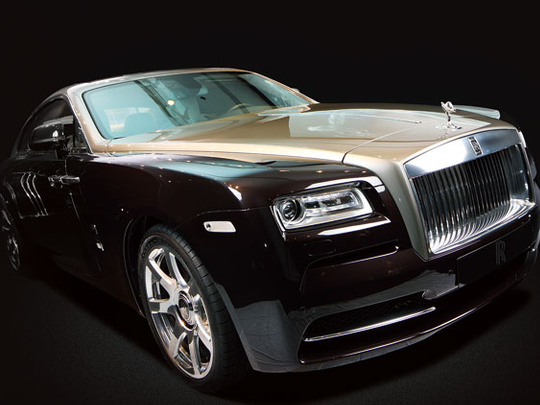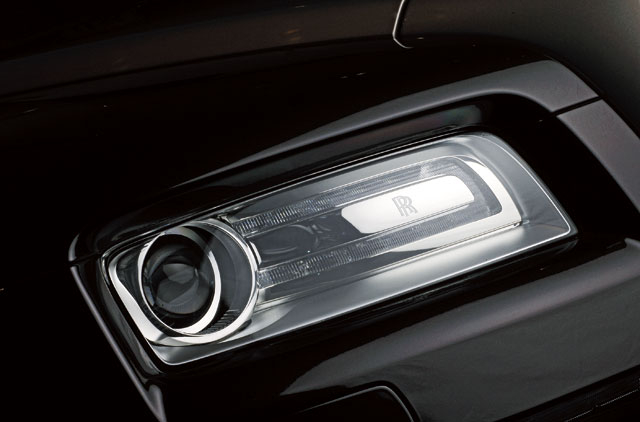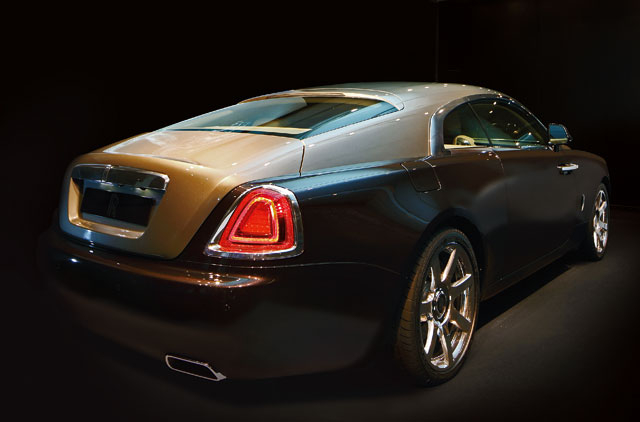
For over a century Rolls-Royce has been the pinnacle of automotive luxury. Many can challenge that statement, but nobody else can claim an idiom as clarifying of this fact, as the famous, “It’s the Rolls-Royce of [insert world-class thing here…]
Well, the new Wraith, a revival of a name first used in 1938, could very likely be the Rolls-Royce of grand touring cars. Company founder Sir Frederick Henry Royce may have died 80 years ago, but his spirit still radiates through Goodwood’s halls. Royce’s words, “Take the best that exists and make it better: when it does not exist, design it,” are at the top of every brief, in the back of every engineer’s mind and on the muse wall above every designer’s desk.
Take the best that exists and make it better: when it does not exist, design it… With a job description like that, Philip Harnett must have been at least a little nervous on his first day with Rolls-Royce. But this ex-Formula 1 engineer and now project manager for the Wraith bridged the seemingly wide gap between motorsport and ultimate luxury with only an effortless skip.
“I’ve been working on the car for about two years now, and before that I spent most of my time in motorsport in Formula 1. It’s actually quite fun to come from motorsport and Formula 1 and now to Rolls-Royce,” says Harnett. “It really isn’t quite a change when you think about it. Formula 1 is about the best engineering, making the best cars in the world and that’s what attracted me to Rolls-Royce. Rolls-Royce makes the best cars in the world, and they’re also the best-engineered cars in the world, full of innovations. So to me it was kind of a simple and natural change from Formula 1, where you only have two customers: two drivers. Well, now I have a few more customers at Rolls-Royce, but still not too many — I see it as quite a natural progression.”
Harnett was an assistant engineer, responsible for all the electronics on a Grand Prix car, as well as for the software, telemetry, engine management, gearbox management, always there in the pits, in the garage, to make sure the car is running at absolute peak performance.
“It’s a fantastic world of professionalism and attention to detail — I learned an awful lot in F1,” he says. “Both these worlds are still very exclusive. You’re still making cars for customers who will not accept anything less than perfection, just like the race drivers — they’re counting on everything to get the ultimate performance, and with Rolls-Royce they are counting on everything to get ultimate performance, but also luxury, style, quality… So it’s a similar task, and you still have to deliver.”
It was specifically the Wraith development that attracted Harnett to join Goodwood. His task was simply to make sure the car makes it from its conceptual phase to a production model, and to provide exactly what his customers want. Of course it’s not all that simple.
“With my background in performance and this being the fastest Rolls-Royce ever made, I think we’re quite a good fit,” says Harnett. “The Wraith is not a sportscar, but it’s definitely performance orientated and very powerful — 624bhp from the twin-turbo V12 and a 0-100kph time of 4.4 seconds. We say it’s the definitive gentleman’s gran turismo. When we talk about that we talk about very long journeys, very fast, incredible comfort, up to four people… And I like to think that if for example you were setting off here coast to coast or another city, if you’re driving a supercar, you might arrive maybe five minutes earlier, but you’ll need a bottle of water and a restroom to freshen up when you arrive. In the Wraith I’m going to arrive straight to the red carpet, straight in to the bar and perfectly relaxed after having a fantastic drive as well.
“It’s bringing this romanticism back into GT motoring. Lots of cars wear the GT badge, but this car is bringing it back from the era of the Fifties and Sixties — it’s a big, graceful, powerful GT.”
The Wraith is cutting-edge automotive technology, yet the inspiration for the car seems to emanate from further back than just the Fifties.
“We surrounded ourselves with inspiration, like Charles Rolls’ aeronautical background, and also the art deco touches inspired by the coupés of the Twenties and Thirties. I remember we were at a briefing and there was a technical problem. We couldn’t get our presentation set up, so the designer just sketched it right there and then, and he used three lines. That was it, three lines to draw the car, and the people we were briefing understood the design completely. You don’t have to see the grille, you don’t have to see the Spirit of Ecstasy to know that this car is a Rolls-Royce.”
In a two-tone finish the Wraith really struts these three defining lines, but I’m assured it looks great in a single hue as well. There are also purposeful artisanal touches around the car to show the craftsmanship involved in creating the Wraith.
“This [cut line] is purposefully put in there [swage line], creating a lot of technical issues because it’s a visible weld line. Normally you can never see the welds; we all try and hide them because they aren’t particularly nice. But this one is put there specifically to make the contrast between the two-tone paint, and it required the absolute latest technology in laser welding. An absolute headache for the engineers, yes, but we are there for the challenge, that’s why we’re at Rolls-Royce.”
Inside the new Wraith the wood door panel is a real signature piece; it’s the largest single-piece wood panel in any production car. As for the sporty, orange accents inside the cabin, they are a nod to Charles Rolls’ aviation pursuits, and you can see the orange detailing on the clocks as well, reminiscent of dials in planes for night-time legibility.
“You’ve Henry Royce who was the engineer, the innovator,” says Harnett. “Charles Rolls was the adventurer and pioneer. He was only 25 when he started Rolls-Royce and that’s incredibly young. I spent a lot of time with our designers, for example Andreas Thurner, head of exterior design. He was 25 years old when he started at Rolls-Royce and he designed the Ghost when he was 25, so he’s got quite a spiritual connection with Charles Rolls.”
Charles Rolls was the first person to cross the English Channel and come back again in an aeroplane, and he was flying these contraptions when they were made of sticks and cardboard.
“I think this car very much captures that, the spirit of adventure,” adds Harnett. “And I also think of this image when I talk to Andreas Thurner about Charles Rolls; I see him maybe driving in an endurance race in the morning, you know, with the goggles on, and then they take off the goggles and they’re covered in mud and oil, really on-the-edge stuff… But then in the afternoon he’s in London in the finest gentleman’s club in Pall Mall, moustache perfectly waxed, a white dinner jacket…
“For me, working at Rolls-Royce… The company has been around for 109 years since 1904 and I know it’s going to be there for another 109 years after me, so it’s quite daunting. It’s an honour to work here, and to create something new you have to be very, very careful. It’s new, but it has to be 100 per cent Rolls-Royce. I mean this whole design concept is completely new, completely unexpected. It’s very interesting to see the faces and the reactions as we reveal this car. People were not expecting this at all, and that was the idea, to take the brand in a new direction,” says Harnett.
The themes, inspirations and traditions continue with every little detail you discover in the Wraith. And it really is about discovery and exploration with this car. Everywhere you look and everything you caress reveals new textures, temperatures, functions… The back is one of the more iconic views of the car. It’s shaped like a hull, harking back to the ostentatious boat-tail coachbuilt cars of the Twenties and Thirties.
“The two wings on the side are like a catamaran,” adds Harnett. “It’s a very powerful image, and also probably the view most people will get of this car.”
When you move towards the cabin the first things you notice are the trademark rear-hinged doors. “It’s a wonderful sense of occasion to arrive and open this door. We also have this Canadel wood panelling; and there is a story behind that as well. Henry Royce lived in England and he also had a house in a place called Le Canadel in South of France. He had a route down there where he used to test-drive the cars. There’s a cove there, and that’s the main inspiration, because you can see the wood wraps all the way around, like a cove.”
Cutting-edge technology blends seamlessly with the Wraith’s reverence to its history. The infotainment dial on the tunnel console is multi-touch sensitive and accepts pinch and swipe commands just like a Mac Trackpad or tablet. The Wraith is a mix of Rolls-Royce tradition and the latest electronics, as is best exemplified by what’s hiding underneath Goodwood’s sculpted bodywork.
“We have multi-corner suspension and electronic damper control, and we also have a supplementary anti-roll system. It enables us to have that beautiful soft ride, and in the corner the systems are there to tighten it up and give it excellent handling. It’s got more direct steering, shorter wheelbase, wider rear track… When I drive Rolls-Royces I drive them around the beautiful country roads around Goodwood — quite curvy roads. The Wraith gives you the confidence; you know where every inch of the car is.”
The sporty, or sportier, nature of this car is subtly demonstrated with the slightly thicker steering wheel rim and showier engine note, but there is absolutely no need in a Rolls-Royce to have a separate sports button. It goes against the brand’s nature of effortless power — it’s just poor form to have to engage a different electronic mode and call on the reinforcements.
“Do you need a sports mode? Do you want to get in this car and have to change the driving mode? The suspension? That’s not a Rolls-Royce. As soon as you get into the car, it’s all there. During the development phase I did lots of driving; performance cars, supercars, sportscars… It’s a nice part of the job, but I remember afterwards getting into the Rolls-Royce, closing the door and thinking, ‘You’re home’.”
A key technical highlight of the Wraith is also its new Satellite Aided Transmission (SAT). The system is map-dependant on the data available for a particular country, but it will work in the Middle East. SAT also knows, or learns, a drive, and can see what kind of corners you’re taking and how fast you’re driving through them.
“SAT is a brilliant innovation,” says Harnett. “I stopped doing Formula 1 in 2009/2010, and one of my colleagues used to do the gearbox software for F1 cars. He called me one day and said ‘Phil, I’ve got something new, you’ve got to come over and test this.’ So we went out and drove with this Satellite Aided Transmission. In the Wraith how it does that is using the car’s GPS system to make sure you’re always in the right gear. It can see other cars on the road, and because of the maps and satellites it can see the corners, the junctions, the roundabouts, it can see everything coming up. So if for example you’re coming up to a corner, the car knows that you’re taking your foot off the accelerator because you want to cruise, so it won’t change up, but will keep you in your gear, and when you turn the car and put your foot on the accelerator again the power is seamlessly there,” says Harnett.
Seamlessly there… It just appears, like an apparition, like a Wraith. From out of nowhere. Well, maybe not out of nowhere; out of a twin-turbo V12 to be exact, but with this seemingly unlikely blend of different worlds — history and the future, motorsport and luxury — Rolls-Royce has created a car that, really, didn’t exist.
“When it does not exist, design it…” Harnett can sleep easy.
















